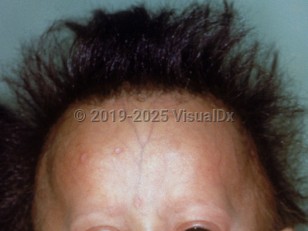Progeria in Child
Alerts and Notices
Important News & Links
Synopsis

Progeria, also known as Hutchinson-Gilford syndrome, is a rare disease of accelerated aging associated with a mutation in the nuclear envelope protein lamin A. Patients typically appear normal at birth but develop, often within the first 1-2 years of life, the characteristic facial features and sclerodermoid skin changes. These patients have short stature, poor weight gain, and failure to thrive in addition to changes classically found in the elderly, including osteoporosis and atherosclerosis.
Characteristic facial features of progeria include loss of subcutaneous fat, a thin "beaked" nose, and a large cranium with sparse hair. Patients have a high-pitched voice and normal intelligence.
Progeria is a chronic and progressive disease. Most patients succumb to atherosclerotic complications by the second decade of life.
In November 2020, the US Food and Drug Administration (FDA) approved the first treatment to reduce the risk of mortality in patients with progeria.
Characteristic facial features of progeria include loss of subcutaneous fat, a thin "beaked" nose, and a large cranium with sparse hair. Patients have a high-pitched voice and normal intelligence.
Progeria is a chronic and progressive disease. Most patients succumb to atherosclerotic complications by the second decade of life.
In November 2020, the US Food and Drug Administration (FDA) approved the first treatment to reduce the risk of mortality in patients with progeria.
Codes
ICD10CM:
E34.8 – Other specified endocrine disorders
SNOMEDCT:
238870004 – Progeria
E34.8 – Other specified endocrine disorders
SNOMEDCT:
238870004 – Progeria
Look For
Subscription Required
Diagnostic Pearls
Subscription Required
Differential Diagnosis & Pitfalls

To perform a comparison, select diagnoses from the classic differential
Subscription Required
Best Tests
Subscription Required
Management Pearls
Subscription Required
Therapy
Subscription Required
References
Subscription Required
Last Updated:01/20/2022
Progeria in Child

